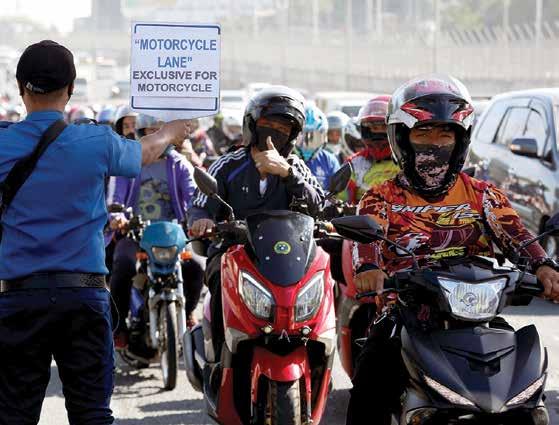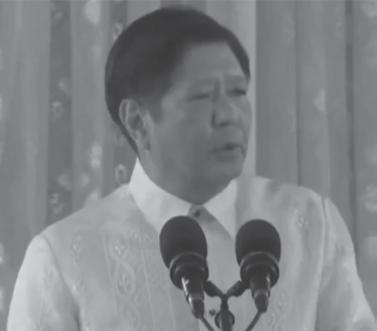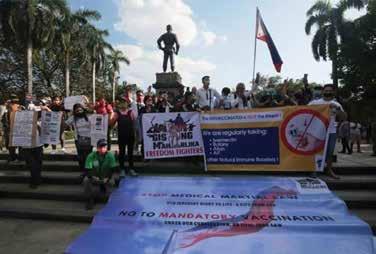
7 minute read
His father’s son?
to help people reach from where they are to where they have never been and, sometimes, can scarcely imagine going. Without leadership, institutions drift, and nations court growing irrelevance and, ultimately, disaster.
“Leaders think and act at the intersection of two axes: the first, between the past and the future; the second, between the abiding values and aspirations of those they lead. Their first challenge is analysis, which begins with a realistic assessment of their society based on its history, mores and capacities. Then they must balance what they know, which is necessarily drawn from the past, with what they intuit about the future, which is inherently conjectural and uncertain. It is this intuitive grasp of direction that enables leaders to set objectives and lay down a strategy.
Advertisement
“For strategies to inspire the society, leaders must serve as educators — communicating objectives, assuaging doubts and rallying support. While the state possesses by definition the monopoly of force, reliance on coercion is a symptom of inadequate leadership; good leaders elicit in their people a wish to walk alongside them. They must also inspire an immediate entourage to translate their thinking so that it bears upon the practical issues of the day. Such a dynamic surrounding team is the visible complement of a leader’s inner vitality; it provides support for the leader’s journey and ameliorates the dilemmas of decision. Leaders can be magnified — or diminished — by the qualities of those around them...
“Leadership is most essential during periods of transition, when values and institutions are losing their relevance, and the outlines of a worthy future are in controversy. In such times, leaders are called upon to think creatively and diagnostically: what are the sources of a society’s well-being? Of its decay? Which inheritances from the past should be preserved, and which adapted or discarded? Which objectives deserve commitment, and which prospects must be rejected no matter how tempting? And, at the extreme, is one’s society sufficiently vital and confident to tolerate sacrifice as a way station to a more fulfilling future?”
It is a big book (495 pages) and contains six large studies in world leadership: Germany’s Konrad Adenauer; France’s Charles de Gaulle; America’s
Richard Nixon; Egypt’s Anwar Sadat; Singapore’s Lee Kuan Yew; and Britain’s Margaret Thatcher. Every word of it is a “must read” for anyone interested in leadership. But BBM has access to models beyond these. He has his own father to learn from, especially at this time.
At the height of the Vietnam war in October 1966, U.S. President Lyndon Johnson asked Marcos to host a summit meeting in Manila of the seven Vietnam war allies. These included Australian Prime Minister Harold Holt, South Korean President Park Chung Hee, New Zealand Prime Minister Keith Holyoke, Thai Prime Minister Thanom Kittikachorn, L B Johnson, Vietnamese Chairman Nguyen Van Thieu, Vietnamese Prime Minister Nguyen Cao Ky, and of course, the host, Marcos.
After Johnson got the other allies to commit combat troops to Vietnam, he tried to bamboozle Marcos to do the same. He passed on to Marcos a small piece of paper with a note on it, but Marcos rolled it into a ball, put it inside an empty matchbox, and threw it inside the ashtray in front of the U.S. president. Johnson called on Secretary of State Dean Rusk and Defense Secretary Robert history where China too has been colonized and occupied by foreign powers.
On this day we witnessed China’s newest Premier Li Qiang, a former party head of Shanghai who has been credited with bringing in Tesla’s biggest factory outside of the U.S. Hence, if we were to take a few lessons from China in the first quarter of 2023, perhaps it would be the stabilizing growth it has achieved in terms of their economy and, if we would look into the level of goals in terms of food security, I would pay attention to the way they boost the areas of culture, ecology and economy to promote rural revitalization.
So therefore, where does the Philippines stand? Where do we see ourselves in the next five years? Focusing on education alone, the Philippines seems to still largely lag behind in reading, math and science, considering we’re one of the smartest people in the world. Friend to all enemy to none – a foreign policy that, to me, certainly equips our education system better as development focuses on advancement and peace rather than politics.
The Philippines, as the rest of the world knows, is indeed the pearl of the orient – what are we Filipinos ready to do then to preserve and advance as a nation, as a people with so much potential yet still much to learn? I suppose the key word is “learn” and we must be ready to do so by developing the areas we can firmly capitalize on. (Philstar.com) * * * The opinions, beliefs and viewpoints expressed by the author do not necessarily reflect the opinions, beliefs and viewpoints of the Asian Journal, its management, editorial board and staff.
President Ferdinand Marcos Jr. Screengrab photo from RTVM Facebook

McNamara to say something to the allies, then concluded his remarks by saying that unless they all worked together they couldn’t beat the communists in Vietnam. Ultimately Marcos agreed to dispatch a contingent of civic action volunteers. This became known as Philcag, our non-combat troops in Tay Ninh.
Using Marcos Sr.’s example as a model, Marcos Jr. could have expressed support for U.S. “military operations other than war,” in lieu of U.S. operational sites under our 2014 Enhanced Defense Cooperation Agreement inside Philippine military bases for use in a possible war with China on Taiwan. He could have avoided the restive populations of Isabela and Cagayan provinces who want no involvement in America’s future war.
* * *
The opinions, beliefs and viewpoints expressed by the author do not necessarily reflect the opinions, beliefs and viewpoints of the Asian Journal, its management, editorial board and staff.
* * * fstatad@gmail.com
SWS: 69% of 9.5M unvaccinated
Filipinos unwilling to get COVID-19 shot
MANILA — A survey conducted in December 2022 by private pollster Social Weather Stations revealed that 69% of the estimated 9.5 million adult Filipinos who have not been vaccinated against COVID-19 still refuse to get the shot.
Only 12% of unvaccinated adults are willing to get the vaccine, some 50 million to up to over 60 million doses of which are expiring this month, according to testimony by the Department of Health during a Senate hearing last week.
The SWS said 57% of adults or 41.14 million are fully vaccinated, while 6% or 4.4 million have only received the first dose of the shot. Of them, 44% said they are unwilling to get a booster dose, while 32% said they are fine with getting it.
The pollster said 17% of adults or 12.4 million have received their third shot or the first booster, while 6% or 4.3 million got the fourth dose or the second booster.
Of those who have received their first booster, 55% said they are
Anti-vaccine protesters gather at Liwasang Bonifacio in Manila on Tuesday, Jan. 11, 2022 to rail against government restrictions against those who have not received the shot against COVID-19. The STAR / willing to get another shot, while 32% said they are unwilling.

The SWS conducted the survey through face-to-face interviews of 1,200 Filipinos aged 18 and above. It did not say whether their survey staff asked for proof of vaccination during the interviews. The National COVID-19
Vaccination Dashboard shows that as of Thursday, March 16, a total of 179,046,847 doses have been administered. This includes 75,705,650 doses given for the first shot, 79,165,853 for the second shot and 24,176,344 for the booster dose. (By Xave Gregorio/Philstar.com)
Scammers took consumers for $8.8 billion in 2022
by PETER WHITE Ethnic Media Services
$3.8 BILLION in investment scams and $2.6 billion in impersonator scams topped the list. Most money lost through bank transfers and crypto currencies.
Ever get an email about an extended car warranty or a free gift from Home Depot? What about online service to flush out malware from your computer?
It’s hard to avoid these unsolicited offers. Fraudsters send texts, they call you on your phone, and sometimes use AI to mimic a relative’s voice who says they have an emergency and please send money.
The Federal Trade Commission (FTC) says what you don’t know can be expensive. They received 2.4 million complaints last year compared to 2.9 million in 2021 but the total amount lost in 2022 was $2.6 billion more than in 2021.
“The dollar loss reported was staggering. Consumers reported that they lost more than $8.8 billion to fraudsters, the most ever reported,” say Maria Mayo, Associate Director for the Division of Consumer Response and Operations in the Bureau of Consumer Protection at the Federal Trade Commission (FTC). The FTC maintains a database of consumer fraud reports. Report a scam here.
“We know that fraud affects every community and that scammers are running their scam in the languages that people speak at home. And that’s why the FTC now has information in a dozen languages to help people spot and avoid these scams,” says Cristina Miranda, Consumer Education Specialist with the FTC’s Education Bureau of Consumer Protection.
Scammers targeting ethnic communities
During an March 10 Ethnic Media Services briefing Miranda briefed reporters about how to protect against fraudsters. She said that recent refugees and immigrants are frequent marks for scammers who use their native language to steal their money.
“We have a downloadable publication called Spotting, Avoiding and Reporting Scams: a Fraud Handbook. It helps people learn to spot some of the scams related to looking for a job, going through the immigration process, or just trying to figure out how things work in this country,” she said.
“Scammers are targeting ethnic communities and they speak your language. They target ethnic communities in unique ways,” says Rosario Mendez, an attorney with FTC’s Division of Consumer and Business Education Bureau of Consumer Protection.
The Latino community filed a higher percentage of reports relating to problems with banks and lenders, related to debt collection, auto issues, and also business opportunities.
“And we’ve had several cases related to bogus business opportunities, bogus work at home, specifically targeting Latinos. We know from our data analysis and from also our casework that business opportunity, moneymaking schemes, are also something that is impacting the Latino community.
In terms of the black community, the largest number of reports were about payday loan applications, and also student debt relief programs,” Mendez said.
An October 2021 FTC report, Serving Communities of Color, detailed the extent of fraud affecting ethnic communities and the FTC’s efforts to combat it.
Scams vary widely Mayo said a lot of people fell prey to get-rich-quick schemes last year and the average median loss per consumer was $5,000.
“Consumers reported losing money to investment scams more than any other type of scam, and the amount lost in




